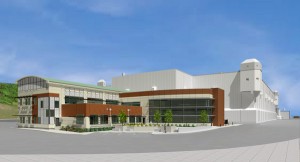
Pictured above is the proposed Uranium Processing Facility at the Y-12 National Security Complex, with the administrative area in the front and the fortified section of the building in the rear. (Submitted image)
The budget request announced this week for the National Nuclear Security Administration includes a slight increase in spending for the proposed multi-billion-dollar Uranium Processing Facility at the Y-12 National Security Complex.
The $335 million request for UPF in Fiscal Year 2015, which starts Oct. 1, is up slightly from $326 million in FY14. That’s roughly a 2.8 percent increase.
The UPF project, which has an official cost estimate of up to $6.5 billion, is part of a broader effort to modernize Y-12, including its production facilities. The 811-acre plant was built during World War II to help enrich uranium for the world’s first atomic weapons.
But questions have been raised about rising cost projections and a redesign of the UPF. In February 2013, the NNSA said the redesign could add $539 million to the project cost and extend its schedule.
During a conference call with reporters on Tuesday, NNSA Acting Administrator Bruce Held said the agency wants to get workers out of Building 9212 at Y-12 by 2025.
“We think it’s prudent to set that line in the sand,†Held said.
Plans had once called for the UPF to start operating as early as 2023.
The project is currently under review by a so-called Red Team that is led by Oak Ridge National Laboratory Director Thom Mason.
On Tuesday, NNSA officials—including Held, Anne Harrington, Don Cook, and Bob Raines—said there were many components of the project that were going to be done this year, regardless of the Red Team review and current budget issues. Those include work on design and technology development, and seismic studies and safety analyses.
Some lessons learned from the project to replace the Chemistry and Metallurgy Research Facility at Los Alamos National Laboratory could be applied to the UPF, Held said. That could translate into a “more modular approach†at the UPF project, NNSA officials said.
The NNSA budget request, which also includes a total of $1.16 billion for Y-12, includes a 4 percent increase in overall spending.
“There has been some pain,†Held said, particularly on nuclear nonproliferation work. And the MOX project in South Carolina, a first-of-its-kind nuclear facility, has been put on “full standby†because of cost overruns. Federal officials will study other options ranging from a geologic repository to using canisters to dispose of some 34 metric tons of plutonium.
NNSA officials said they have balanced the needs of their agency—ensuring a safe nuclear deterrent, working on nuclear nonproliferation, and supplying nuclear fuel for the navy—against federal budget constraints.
The budget request still has to be considered by Congress.
Leave a Reply